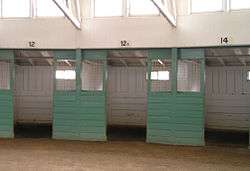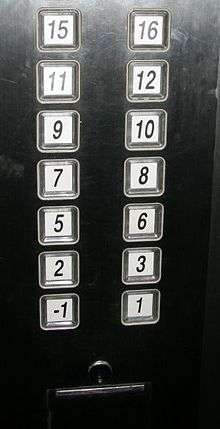Triskaidekaphobia

Triskaidekaphobia (pronunciation: /ˌtrɪskaɪˌdɛkəˈfoʊbiə, ˌtrɪskə-/, TRIS-kye-DEK-ə-FOH-bee-ə or TRIS-kə-DEK-ə-FOH-bee-ə; from Greek tris meaning "three", kai meaning "and", deka meaning "10" and phobos meaning "fear" or "morbid fear") is fear or avoidance of the number 13. It is also a reason for the fear of Friday the 13th, called paraskevidekatriaphobia (from Παρασκευή Paraskevi, Greek for Friday) or friggatriskaidekaphobia (after Frigg, the Norse goddess after whom Friday is named in English).
The term was used as early as in 1910 by Isador Coriat in Abnormal Psychology.[1]
Origins
Judas theory
From the 1890s, a number of English language sources relate the "unlucky" thirteen to an idea that at the Last Supper, Judas, the disciple who betrayed Jesus, was the 13th to sit at the table.[2] However, the Bible itself says nothing about the order in which the Apostles sat. Also, the number 13 is not uniformly bad in the Judeo-Christian tradition. For example, the attributes of God (also called the Thirteen Attributes of Mercy) are enumerated in the Torah (Exodus 34:6–7). Some modern Christian churches also use 13 attributes of God in sermons.
Hammurabi theory
There is a myth that the earliest reference to thirteen being unlucky or evil is from the Babylonian Code of Hammurabi (circa 1780 BC), where the thirteenth law is omitted. In fact, the original Code of Hammurabi has no numeration. The translation by L.W. King (1910), edited by Richard Hooker, omitted one article:
If the seller have gone to (his) fate (i. e., have died), the purchaser shall recover damages in said case fivefold from the estate of the seller.
Other translations of the Code of Hammurabi, for example the translation by Robert Francis Harper, include the 13th article.[3]
Other theories
Triskaidekaphobia may have also affected the Vikings: It is believed that Loki was the 13th god in the Norse pantheon—more specifically, Loki was believed to have engineered the murder of Balder and was the 13th guest to arrive at the funeral.[4] This is perhaps related to the superstition that if 13 people gather, one of them will die in the following year. However, the oldest source of this myth, Lokasenna, has far more than 13 guests (17 of the guests are mentioned by name) so this example should not be taken too seriously.[5] Another Norse tradition involves the myth of Norna-Gest: When the uninvited norns showed up at his birthday celebration (thus increasing the number of guests from ten to thirteen), they cursed the infant by magically binding his lifespan to that of a mystic candle they presented to him.
Events related to unlucky 13
Apollo 13 launched on April 11, 1970 at 13:13:00 CST and experienced an oxygen tank explosion on April 13 at 21:07:53 CST. It later returned safely to earth on April 17.[6][7]
On Friday, October 13, 1307, the arrest of the Knights Templar was ordered by Philip IV of France. While the number 13 was considered unlucky, Friday the 13th was not considered unlucky at the time. The incorrect idea that their arrest was related to the phobias surrounding Friday the 13th was invented early in the 21st century and popularized by the novel The Da Vinci Code.[8]
In 1881 an influential group of New Yorkers led by US Civil War veteran Captain William Fowler came together to put an end to this and other superstitions. They formed a dinner cabaret club, which they called the Thirteen Club. At the first meeting, on Friday, January 13, 1881, at 8:13 p.m., thirteen people sat down to dine in Room 13 of the venue. The guests walked under a ladder to enter the room and were seated among piles of spilled salt. Many Thirteen Clubs sprang up all over North America over the next 40 years. Their activities were regularly reported in leading newspapers, and their numbers included five future US presidents, from Chester A. Arthur to Theodore Roosevelt. Thirteen Clubs had various imitators, but they all gradually faded from interest.[9]
Vehicle registration plates in the Republic of Ireland are such that the first two digits represent the year of registration of the vehicle (i.e., 11 is a 2011 registered car, 12 is 2012, and so on). In 2012, there were concerns among members of the Society of the Irish Motor Industry (SIMI) that the prospect of having "13" registered vehicles might discourage motorists from buying new cars because of superstition surrounding the number thirteen, and that car sales and the motor industry (which was already ailing) would suffer as a result. The government, in consultation with SIMI, introduced a system whereby 2013 registered vehicles would have their registration plates' age identifier string modified to read "131" for vehicles registered in the first six months of 2013 and "132" for those registered in the latter six months of the year.[10] The main reason for this however, is to increase the number of car sales in the latter months of the year. Even though 70% of new cars are bought during the first four months of the year, some consumers believe that it doesn't accurately reflect the real age of a new car, since cars bought in January will most likely have been manufactured the previous year, while those bought later in the year will be actually made in the same year.[11] This system continued after 2013, with vehicles registered in the first half of 2014 labelled "141" rather than "14".
Similar phobias

- Number 666 or 616 (Hexakosioihexekontahexaphobia), see Number of the Beast.
- Tetraphobia, fear of the number 4. In China, Taiwan, Singapore, Malaysia, Japan, Korea and Vietnam etc. as well as in many other East-Asian and some Southeast-Asian countries, it is not uncommon for buildings (including offices, apartments, hotels) to lack floors with numbers that include the digit 4, and Finnish mobile phone manufacturer Nokia's 1xxx-9xxx series of mobile phones does not include any model numbers beginning with a 4. This originates in Chinese, where the pronunciation of the word for "four" (四, sì in Mandarin) is very similar to that of the word for "death" (死, sǐ in Mandarin), and remains such in the other countries' Sino-Xenic vocabulary.
- 17 is an unlucky number in Italy, probably because in Roman digits 17 is written XVII, that could be rearranged to "VIXI", which in Latin means "I have lived" but can be a euphemism for "I am dead." In Italy, some planes have no row 17 and some hotels have no room 17.[12]
- Paraskevidekatriaphobia is the fear of Friday the 13th, which is considered to be a day of bad luck in a number of western cultures. In Romania, Greece and some areas of Spain and Latin America, Tuesday the 13th is similarly considered unlucky.[13]
- Curse of 39, a belief in some parts of Afghanistan that the number 39 (thrice thirteen) is cursed or a badge of shame.
Lucky 13
In some regions 13 is considered a lucky number. For example, 13 is lucky in Italy except in some contexts, such as sitting at the dinner table.[14] Colgate University was started by 13 men with $13 and 13 prayers, so 13 is considered a lucky number. Friday the 13th is the luckiest day at Colgate.[15]
Several Venezuelan sportspeople have chosen 13 as squad number, most notably Dave Concepción, Omar Vizquel, Oswaldo Guillén and Pastor Maldonado.
See also
Notes
- ↑ "Abnormal Psychology" p. 319, published in 1910, Moffat, Yard and company (New York). Library of Congress Control No. 10011167.
- ↑ Cecil Adams (1992-11-06). "Why is the number 13 considered unlucky?". The Straight Dope. Retrieved 2011-05-13.
- ↑ English translation of the Code of Hammurabi Online Library of Liberty.
- ↑ Oberon Zell-Ravenheart, "Companion for the Apprentice Wizard", Career Press (2006), p 200.
- ↑ http://runeberg.org/eddan/se-08.html
- ↑ http://www.universetoday.com/63342/13-things-that-saved-apollo-13-part-9-position-of-the-tanks/
- ↑ http://www.spaceacts.com/newsap13.html
- ↑ Robinson, John J. (1990). Born in Blood: The Lost Secrets of Freemasonry. ISBN 978-0-87131-602-8.
- ↑ Nick Leys, If you bought this, you've already had bad luck, review of Nathaniel Lachenmayer's Thirteen: The World's Most Popular Superstition, Weekend Australian, 8–9 January 2005
- ↑ 2013 number plates to be changed to avoid ‘unlucky 13’, Irish Independent, 24 August 2012
- ↑ "2013 Number Plates To Be Changed To Avoid 'Unlucky 13'". Irish Independent.
- ↑ Harris, Nick (15 November 2007). "Bad omen for Italy as their unlucky number comes up". The Independent. London.
- ↑ Tuesday is generally unlucky in Greece for the fall of Byzantium Tues 29th May 1453. In Spanish-speaking countries, there is a proverb: En martes no te cases, ni te embarques 'On Tuesday, do not get married or set sail'.The 13th card in Tarot's major arcana is Death.
- ↑ "Aggiungi un posto a tavola, siamo in 13!" (in Italian). Retrieved 31 March 2012.
- ↑ Colgate University. "Lucky 13". Retrieved 20 February 2015.
References
- Lachenmeyer, Nathaniel (2004). 13: The Story of the World's Most Popular Superstition. New York: ISBN 1-56858-306-0.
- Havil, Julian (2007). Nonplussed: Mathematical Proof of Implausible Ideas (Hardcover). Princeton University Press. p. 152. ISBN 0-691-12056-0.
- O'Neil, Daniel (2008). "Fear of 13: Tales over dinner."
- Coriat, I.H. (1910). "Abnormal Psychology", p. 319, published in, Moffat, Yard and company (New York). Library of Congress Control No. 10011167.
External links
| Wikimedia Commons has media related to Triskaidekaphobia. |
- 'Unlucky' airline logo grounded BBC, 21 February 2007
- Would you buy a number 13 house? BBC Magazine, Friday, 12 December 2008
- Triskaidekaphobia on MathWorld
- Who's Afraid Of Friday The 13th? on NPR